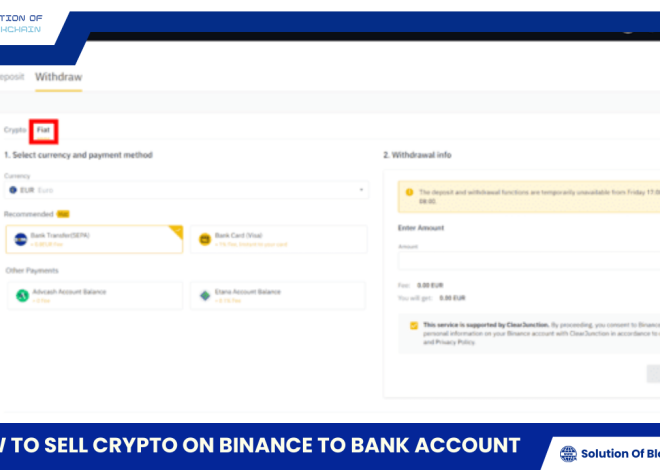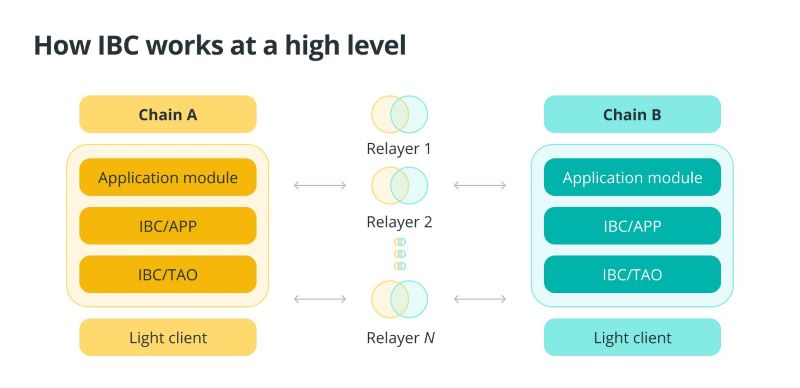
Is Inter Blockchain Communication protocol (IBC) the Key to unlocking the full potential of blockchain technology?
Discover the Inter Blockchain Communication protocol, the revolutionary technology that’s breaking down barriers and enabling seamless communication between different blockchain networks
What is Inter Blockchain Communication protocol?
The Inter Blockchain Communication (IBC) protocol is an open-source protocol engineered to enable the transfer of messages between distinct distributed ledgers. Its primary purpose is to connect independent blockchains, allowing them to share data, assets, and interact with one another. IBC addresses the issue of blockchain isolation by fostering a trustless environment for communication and value exchange, particularly with tokens.

Introduced in 2019 by Cosmos Network, IBC aims to create a more accessible and scalable blockchain ecosystem. The Interchain Foundation (ICF) further developed Interchain Standards (ICS) to outline the essential functions for IBC within the Cosmos environment.
IBC’s significance lies in its ability to address the prevalent challenge of cross-chain messaging. This is particularly valuable for exchanges facilitating swaps, application-specific blockchains where assets often originate, and private blockchains seeking connections with other chains, whether private or public.
Key features of the Inter Blockchain Communication protocol
The IBC protocol enables secure and trustless communication between interconnected blockchains through dedicated channels and the utilization of smart contract modules. Notably, it fosters interoperability among blockchains without necessitating direct interaction. This is achieved by transmitting information packets via specialized channels, which employ smart contract modules equipped with a light client to authenticate the received state.
IBC’s trustless and permissionless nature allows anyone to act as a relayer, ensuring that blockchains can exchange value or data without requiring trust between the participating parties. This feature is crucial for achieving blockchain sovereignty while avoiding isolation, a primary objective of the Cosmos ecosystem.
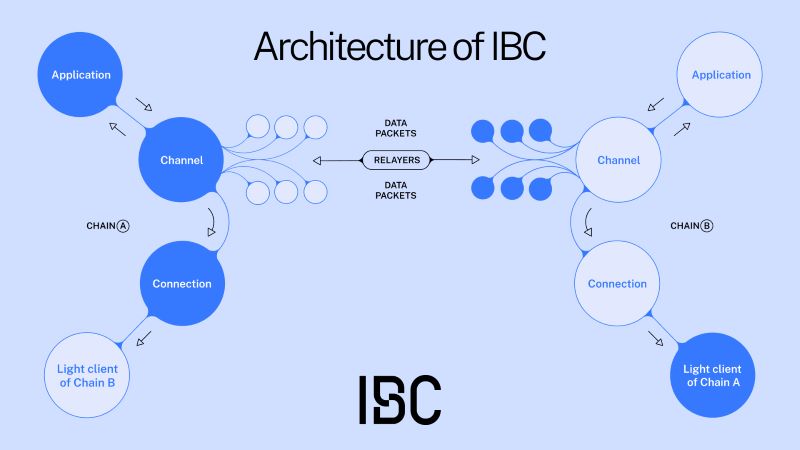
The integration of smart contract modules with light client verification enhances security by validating information exchanged between blockchains without direct communication. This eliminates the need for blind trust and bolsters the overall security of the ecosystem. IBC further guarantees the security and integrity of cross-chain transactions through cryptographic techniques and consensus mechanisms like Tendermint.
Data privacy and integrity remain paramount throughout transmission, ensuring the confidentiality and accuracy of information exchanged between blockchains.
How does the Cosmos IBC Operate?
The IBC protocol transforms how blockchains communicate, enabling a smooth exchange of data between them. It functions on two distinct levels: the TAO layer, responsible for transport, authentication, and ordering; and the APP layer, which focuses on application-specific details. The TAO layer acts as the foundation, establishing secure connections and verifying data, while the APP layer defines how data is formatted and interpreted across different blockchains.
Within the Interchain Standard, the client ensures trustless verification of data, while the relayer facilitates the transfer of information between blockchains. This creates a robust framework where the standard sets the protocol rules, the client guarantees data integrity, and the relayer manages the actual transfer, fostering seamless communication between diverse blockchains.
IBC’s core operation relies on hubs and zones, packet transactions, and smart contracts. Hubs act as central routers connecting individual blockchains, known as zones. They facilitate the relay of transactions and data between zones, enabling cross-chain communication.
Packet transactions are units of data exchanged between blockchains, containing sender, recipient, and transaction details. Smart contracts, integrated into IBC/TAO modules on each blockchain, ensure the orderly transfer of these packets.
The data transfer process is simple: A user initiates a cross-chain transaction, the packet travels from the source zone to a hub, and then the hub relays it to the destination zone. The destination blockchain sends a response back through the same route. The TAO layer handles the infrastructure and security of data packet transfer, while the APP layer determines the data’s format and meaning for both the sending and receiving blockchains.
How secure is Inter Blockchain Communication?
IBC achieves robust security through two primary mechanisms: Interchain Accounts and Interchain Security.
Interchain Accounts (ICAs): ICAs enable seamless cross-chain communication, allowing users to interact with one blockchain from another without switching. Think of it as controlling a remote account on a different platform. This streamlines cross-chain activities and enhances compatibility between blockchains.
Interchain Security (ICS): ICS empowers newer or less-established blockchains within the IBC network to “borrow” security from more mature chains. This means they can leverage the existing validator set of a trusted chain, like the Cosmos Hub, without needing to build their own from scratch. This significantly boosts the security of fledgling chains and allows them to focus on their unique functionalities, contributing to the vision of Cosmos as a network of interconnected blockchains.
Together, ICAs and ICS create a robust security framework that promotes interoperability and innovation within the IBC ecosystem. By allowing chains to specialize in specific use cases and leverage shared security, IBC fosters a more secure and diverse blockchain landscape.
Implications of the Inter Blockchain Communication protocol for various stakeholders
The IBC protocol has far-reaching implications for various stakeholders in the blockchain ecosystem:
For users, IBC enhances the overall experience by providing access to a wider range of decentralized applications (dApps) and services across multiple blockchain platforms. It allows for secure and efficient transfer of digital assets like tokens and cryptocurrencies, enabling users to explore new opportunities and manage their portfolios more effectively.
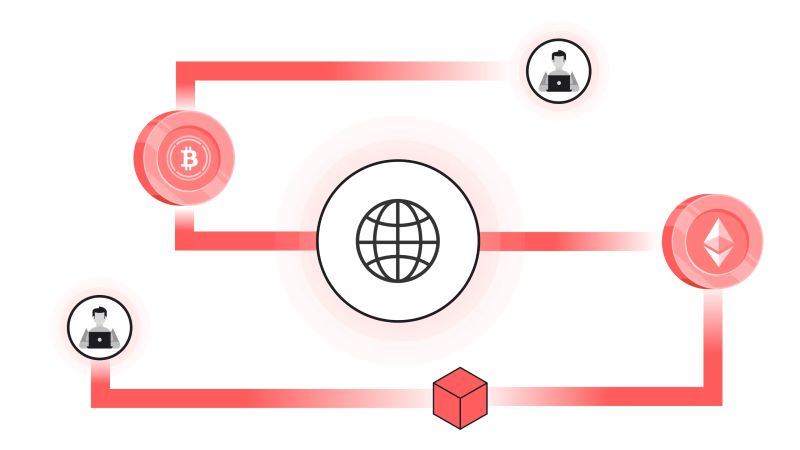
Traders benefit from IBC by gaining increased trading potential and flexibility across different blockchain networks. They can execute cross-chain transactions, diversify their portfolios, exploit price differences, and access liquidity pools across platforms, ultimately enhancing their trading strategies.
IBC empowers developers to build innovative dApps and improve existing ones by leveraging interoperability features. They can create sophisticated decentralized ecosystems like DEXs, gaming networks, and DeFi platforms, thanks to the seamless communication and asset transfer capabilities enabled by IBC. Additionally, IBC streamlines the development process by offering standardized protocols and toolkits for establishing cross-chain communication channels, reducing development time and costs.
The future of the IBC protocol
The IBC protocol holds immense promise in shaping the future of the cryptocurrency landscape. By facilitating seamless communication between diverse blockchains, it breaks down barriers and fosters a more connected, robust, and inclusive crypto environment. This interoperability lowers entry barriers and opens doors for collaboration, enabling the development of complex dApps, innovative financial products, and thriving ecosystems through the free flow of assets and data across chains.
Users can now seamlessly interact with multiple networks, enjoying the benefits of various platforms without compromising security or rewards. This eliminates the trade-off between token swapping and direct network participation, enhancing user experience and expanding possibilities.
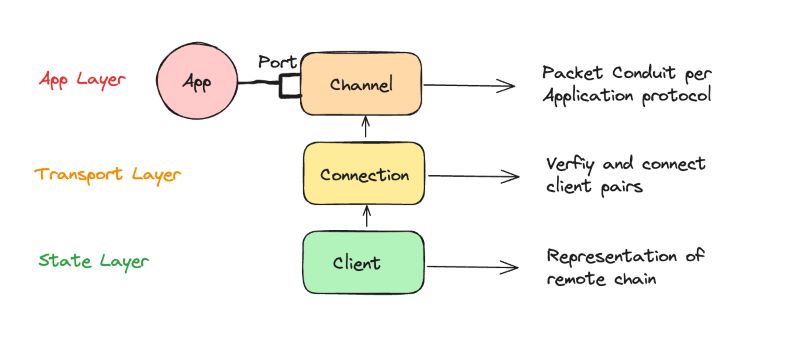
However, the realization of IBC’s full potential depends on addressing technical challenges and establishing effective governance frameworks. The absence of standardization could lead to fragmentation as competing protocols emerge, hindering progress. To achieve a truly integrated crypto ecosystem, collaboration and standardization across blockchain projects are essential.
In conclusion, the IBC protocol is a beacon of innovation, promising a future where diverse blockchains can coexist and interact harmoniously. By addressing the challenges and fostering collaboration, IBC can unlock the true potential of interoperability, transforming the crypto landscape into a unified and thriving ecosystem.
Inter Blockchain Communication (IBC) emerges as a groundbreaking solution, addressing the long-standing challenge of blockchain interoperability. By enabling seamless communication and data exchange between different blockchains, IBC unlocks a new era of innovation and collaboration in the decentralized world.
As the blockchain ecosystem continues to grow and evolve, IBC will play a pivotal role in shaping its future. By breaking down barriers between isolated networks, IBC fosters a more interconnected, interoperable, and ultimately, more powerful blockchain landscape.
Visit Solution Of Blockchain for cutting-edge insights, expert analysis, and innovative solutions in the world of blockchain interoperability. Unlock the true potential of your blockchain projects with Inter Blockchain Communication!



